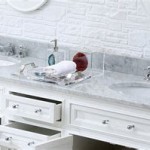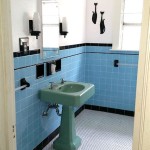What Paint Should I Use On Bathroom Walls?
Selecting the appropriate paint for bathroom walls is a crucial decision that significantly impacts the longevity and aesthetic appeal of the space. Bathrooms, by their very nature, are environments characterized by high humidity and frequent temperature fluctuations. These conditions can severely challenge the integrity of standard paint formulations, leading to issues such as peeling, blistering, and the growth of mold and mildew. Therefore, choosing a paint specifically formulated to withstand these challenges is essential for maintaining a durable and attractive bathroom.
The ideal paint for bathroom walls possesses several key characteristics, including moisture resistance, mildew resistance, and washability. Moisture resistance prevents the paint film from absorbing water, which can cause it to swell, crack, and ultimately fail. Mildew resistance inhibits the growth of unsightly and potentially harmful mold and mildew, which thrive in damp environments. Washability allows for easy cleaning of the walls, removing soap scum, water spots, and other common bathroom grime without damaging the paint finish. Understanding these factors is paramount when navigating the wide array of paint options available on the market.
Understanding the Importance of Moisture Resistance
Moisture resistance is arguably the most critical attribute of bathroom paint. Standard paints, particularly those with a matte or flat finish, tend to be porous and readily absorb moisture. This absorption can lead to a cascade of problems. As water penetrates the paint film, it can cause the paint to swell and lose adhesion to the underlying surface. This can result in peeling and blistering, necessitating costly and time-consuming repairs.
Furthermore, absorbed moisture creates an ideal breeding ground for mold and mildew. These microorganisms not only stain the paint and create an unpleasant odor but can also pose health risks, particularly for individuals with respiratory sensitivities. Selecting a paint with a high degree of moisture resistance is therefore paramount to protecting the walls from water damage and preventing mold growth.
Paints formulated for bathroom use typically incorporate resins that create a tighter, less porous film, thus minimizing water absorption. These resins often include acrylics or epoxies, which offer superior water resistance compared to traditional latex paints. It is important to note that even paints labeled as "moisture resistant" can vary in their actual performance. Reading product specifications and reviews can provide valuable insights into the effectiveness of different paints in combating moisture.
Preparation is another key factor in maximizing moisture resistance. Proper surface preparation, including cleaning and priming, can significantly improve the adhesion of the paint and create a more effective barrier against moisture penetration. Addressing any existing moisture problems, such as leaks or condensation, is also essential before applying new paint.
Choosing the Right Paint Finish for Bathroom Walls
The finish of the paint, referring to its sheen or gloss level, plays a significant role in its performance and suitability for bathroom applications. Different finishes offer varying degrees of moisture resistance, washability, and aesthetic appeal. Understanding the characteristics of each finish allows for making an informed decision based on individual needs and preferences.
High-gloss and semi-gloss finishes are generally the most moisture-resistant and easiest to clean. These finishes create a hard, non-porous surface that effectively repels water and resists staining. They are highly washable, allowing for the easy removal of soap scum, water spots, and other bathroom grime. However, high-gloss finishes can also be quite reflective, accentuating imperfections in the wall surface. Therefore, meticulous surface preparation is crucial when using high-gloss paint.
Satin and eggshell finishes offer a balance between moisture resistance and aesthetic appeal. They provide a slightly softer sheen than high-gloss finishes, which can help to conceal minor imperfections in the wall. While not as moisture-resistant as high-gloss finishes, satin and eggshell paints are still sufficiently durable for most bathroom applications, provided that they are specifically formulated for use in humid environments. These finishes are also relatively easy to clean, making them a popular choice for bathroom walls.
Matte and flat finishes are generally not recommended for bathroom walls. These finishes are highly porous and readily absorb moisture, making them susceptible to water damage and mold growth. They are also difficult to clean, as scrubbing can damage the paint film and leave behind unsightly marks. While matte finishes may offer a softer, more contemporary aesthetic, their lack of durability makes them unsuitable for the demanding conditions of a bathroom.
Ultimately, the best paint finish for bathroom walls depends on individual priorities. For maximum durability and ease of cleaning, a high-gloss or semi-gloss finish is recommended. For a more subtle sheen and good overall performance, a satin or eggshell finish is a suitable choice. Matte and flat finishes should be avoided in bathrooms due to their poor moisture resistance and washability.
Addressing Mildew Resistance and Ventilation
Mildew resistance is a crucial aspect of bathroom paint, as bathrooms are inherently prone to the growth of mold and mildew. These microorganisms thrive in damp, poorly ventilated environments and can quickly colonize surfaces, causing unsightly stains, unpleasant odors, and potential health problems.
Paints formulated for bathroom use typically incorporate mildewcides, which are additives that inhibit the growth of mold and mildew. These mildewcides work by disrupting the metabolic processes of these microorganisms, preventing them from colonizing the paint film. While mildewcides are effective in preventing mold and mildew growth, they are not a substitute for proper ventilation and moisture control.
Adequate ventilation is essential for reducing humidity levels in the bathroom and preventing the buildup of moisture. This can be achieved through the use of an exhaust fan, which should be used during and after showering or bathing to remove excess moisture from the air. Opening a window can also help to improve ventilation, but this may not be practical in all bathrooms.
In addition to proper ventilation, addressing any sources of moisture is crucial for preventing mold and mildew growth. Leaky faucets, showerheads, or toilets should be repaired promptly. Condensation on windows and walls should be wiped down regularly. These measures can help to reduce the overall humidity level in the bathroom and create a less favorable environment for mold and mildew growth.
When selecting a paint for bathroom walls, it is important to choose one that is specifically labeled as "mildew resistant." These paints contain higher concentrations of mildewcides and are more effective in preventing mold and mildew growth. However, even the best mildew-resistant paint will not be effective if the underlying conditions that promote mold and mildew growth are not addressed. Proper ventilation, moisture control, and regular cleaning are essential for maintaining a healthy and mold-free bathroom environment.
Furthermore, consider the Long-Term Volatile Organic Compound (VOC) exposure. Choose Low-VOC or zero-VOC paints. These paints release fewer harmful chemicals into the air, contributing to better indoor air quality. Bathrooms are enclosed spaces, making VOC exposure a significant concern. While traditional paints are still available, the benefits of low-VOC paints in terms of health and environmental impact should be seriously considered.
The selection process for bathroom paint extends beyond immediate concerns like color and finish. Long-term maintenance should also be factored in. Paints of high quality and durability will require less frequent repainting, offering cost savings and minimizing disruption. Investigate brands known for their long-lasting formulas and positive reviews. Some manufacturers even offer warranties on their bathroom paints, providing an extra layer of assurance.
Pre-existing conditions in your bathroom also require careful consideration. If there are signs of past mold or mildew growth, thorough remediation is necessary before painting. This may involve cleaning the affected areas with a bleach solution and applying a mold-killing primer. Ignoring pre-existing problems can lead to a recurrence of mold and mildew issues, even with the use of mildew-resistant paint.
Consider the overall design aesthetic of the bathroom when choosing paint. The color and finish of the paint should complement the existing fixtures, tiles, and accessories. Lighter colors can help to brighten a small bathroom and make it feel more spacious, while darker colors can create a more dramatic and luxurious atmosphere. The finish of the paint will also affect the overall look of the bathroom, with high-gloss finishes providing a more modern and sleek appearance, and satin or eggshell finishes offering a more traditional and understated look.
Before purchasing paint, it is advisable to test samples of different colors and finishes in the bathroom. This will allow you to see how the paint looks under the specific lighting conditions of the space and to ensure that it complements the existing décor. Paint samples can be applied to small areas of the wall or to pieces of cardboard. It is also important to allow the paint samples to dry completely before making a final decision, as the color and finish may change slightly as the paint dries.
Application techniques can also affect the outcome. For instance, using a high-quality brush or roller designed for the specific type of paint being used will ensure even coverage and a smooth finish. Multiple thin coats are generally preferable to one thick coat, as this will reduce the risk of drips and runs. Proper surface preparation, including cleaning and priming, is also essential for achieving a professional-looking result.

The Best Paint For Bathrooms Solved Bob Vila

Best Type Of Paint For Bathrooms 2024 Guide Forbes Home

Which Paint Should I Use In A Bathroom Victoriaplum Com

25 Best Bathroom Paint Colors For 2024

25 Best Bathroom Paint Colors For 2024

How To Paint Bathroom Walls Like A Professional Benjamin Moore

Which Paint Should I Use In A Bathroom Victoriaplum Com

Bathroom Paint What To Use In A Ideas

Bathroom Painting Tips Mistakes To Avoid Majestic Cabinets

Which Paint Should I Use In A Bathroom Victoriaplum Com
Related Posts







